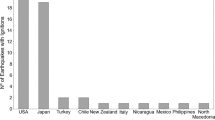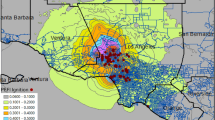Abstract
Relative to other cities in Japan, Kyoto contains an outstanding agglomeration of historic buildings. These historic buildings are crucial for maintaining Kyoto’s irregular ranking as a historical city. However, several active faults occur near Kyoto that could cause severe seismic damage to the city. Thus, post-earthquake fire is one of the most threatening potential disasters that could destroy Kyoto’s invaluable historic buildings. Here, the post-earthquake fire safety of 2,131 historic buildings in the city of Kyoto was analyzed. This analysis was conducted by Monte Carlo simulation with a physics-based urban fire spread model that was formerly developed by the author. This scenario assumes the three following exclusive events that lead to the burn-down of historic buildings: (I) the ignition in the vicinity of the target historic building; (II) inadequate firefighting activity during the initial stage of the fire; and (III) the occurrence of widespread fire in urban areas following ignition. In general, the post-earthquake fire safety of designated and registered historic buildings was greater than that of undesignated and unregistered historic buildings. In addition, in the worst case scenario, 30% of the national treasures and important cultural properties would be damaged in the center of Kyoto city.














Similar content being viewed by others
References
Watts JM, Kaplan ME (2001) Fire risk index for historic buildings. Fire Technol 37:167–180
Bukowski RW, Nuzzolese V (2009) Performance-based fire protection of historical structures. Fire Technol 45:23–42
Copping AG (2002) The development of a fire safety evaluation procedure for the property protection of parish churches. Fire Technol 38:319–334
Aiello M, Astrua F, Nelva R, Vancetti R, Rella M (2002) Fire safety measures in historic buildings for university use. Fire Technol 38:345–362
Santana MLA, Rodrigues JP, Leca Coelho A, Charreau GL (2007) Fire risk assessment of historical areas: the case of Montemor-o-Velho. WIT Trans Eng Sci 58:81–90
Himoto K, Tanaka T (2004) An evaluation of fire resistant performance of Takayama-Sanmachi district based upon fire spread simulation. In: Proceedings of annual meeting of AIJ, vol A2, pp 337–338 (in Japanese)
Himoto K, Akimoto Y, Hokugo A, Tanaka T (2008) Risk and behavior of fire spread in a densely built urban area. Fire Saf Sci 9:267–278
Kawagoe Y, Hasemi Y, Kamiya H, Kobata S, Yasui N, Sakata T, Nagamori H, Murakami M (2008) Reducibility of post-earthquake urban fire hazard in wooden densely inhabited districts by Seismic & fire-resistive reinforcement of low-rise wooden buildings. AIJ J Technol Des 14(2):483–486 (in Japanese)
Himoto K, Tanaka T (2002) A physically-based model for urban fire spread. Fire Saf Sci 7:129–140
Himoto K, Tanaka T (2008) Development and validation of a physics-based urban fire spread model. Fire Saf J 43(7):477–494
Himoto K, Mukaibo K, Kuroda R, Akimoto Y, Hokugo A, Tanaka T (2011) A post-earthquake fire spread model considering damage of building components due to seismic motion and heating of fire. Fire Saf Sci 10:1319–1330
Nakamura T (2012) Construction of GIS database on historic buildings of buddhist temples and shrines in the historic center of Kyoto. AIJ J Technol Des 18(2):765–770 (in Japanese)
Tsukamoto A, Nakamura T (2011) Reconstruction and analysis of the great fire of Tenmei in Kyoto based on illegal journalistic prints and survived buildings. In: Disaster mitigation of cultural heritage and historic cities, vol 5, pp 95–102 (in Japanese)
Kyoto City Fire Department (2003) Estimation report on the impact of expected earthquake disasters in Kyoto City, 3rd ed (in Japanese)
Architectural Institute of Japan (1998) Report on the Hanshin-Awaji earthquake disaster—building series 6. Maruzen Publishing, Tokyo (in Japanese)
Architectural Institute of Japan (2003) Expanded AMeDAS weather data. Maruzen Publishing, Tokyo
Ministry of Education (1996) Announcement No. 6 (in Japanese)
Author information
Authors and Affiliations
Corresponding author
Rights and permissions
About this article
Cite this article
Himoto, K., Nakamura, T. An Analysis of the Post-earthquake Fire Safety of Historic Buildings in Kyoto, Japan. Fire Technol 50, 1107–1125 (2014). https://doi.org/10.1007/s10694-013-0330-0
Received:
Accepted:
Published:
Issue Date:
DOI: https://doi.org/10.1007/s10694-013-0330-0




